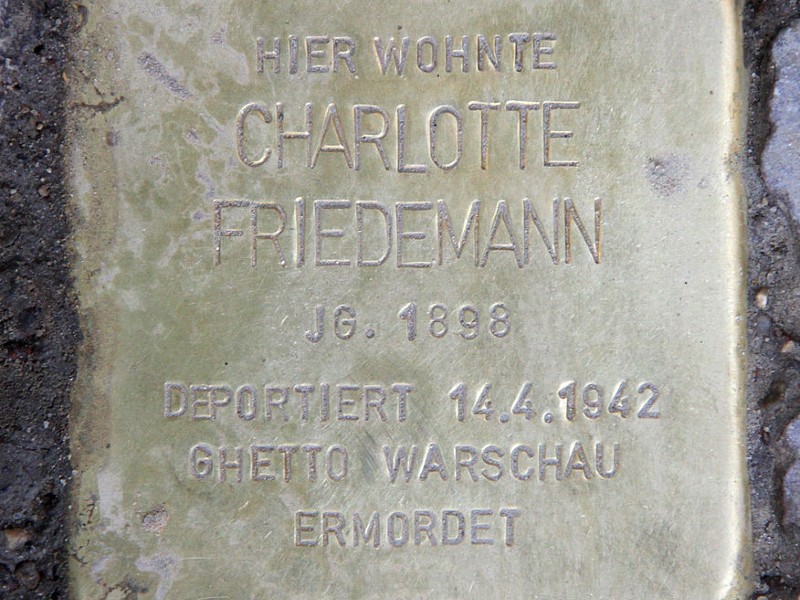Not long ago I received an extraordinary email out of the blue. It was from a man in Berlin named Miklas who explained that he is involved in the Stolpersteine Project.
I had never heard of it, but it didn’t take me long to discover that it’s the inspiration of German painter Gunter Demnig, who was looking for a way to commemorate the lives of people exterminated by the Nazis. Each stolpersteine, roughly translated as “stumbling block,” is a small piece of concrete to which a plain brass plaque, stamped by hand, is affixed. The stone is embedded in the sidewalk so that it lies flush with the pavement, literally underfoot, in front of the last place a person lived voluntarily before being imprisoned, deported or murdered.
Demnig laid the first stolpersteines in Cologne in the early 1990s. The next year he installed some in Berlin. Young people embraced the idea. Residents began to form groups to research who had been persecuted in their district. Before long, the project had spread. Today, it’s the largest decentralized monument to the Holocaust, with more than 70,000 stolpersteines in 24 countries.
Miklas reached out to me because he was researching the lives of the Jews who had lived in his Berlin district of Mariendorf. They included my late husband’s family, the Avigdors. Miklas had uncovered a great deal of information on them, but he hadn’t been able to determine what ultimately happened to them. He’d found me, he said, when he did a Google search for my late father-in-law, Rifat Avigdor. Up came Boy from Berlin, the novel I had written about the family’s escape from Nazi Europe. It led Miklas to my website and email address – and the happy news that the Avigdors would not qualify for a stolpersteine.
I was thrilled and intrigued that a stranger thousands of miles away was doing exactly what I was, looking into my late husband’s family, trying to piece together their lives and what had happened to them all. It’s been a challenge, what with the language barrier – I don’t speak German – and as everyone directly involved, including my husband, is now dead.
I had gleaned some information from letters written by my late father-in-law to the British Air Ministry and Home Office. I knew that in the early 1930s my husband, Heinz (nicknamed Käfer), and his family were living what appeared to be a privileged life in Berlin. Heinz’s father Rifat, originally from Constantinople, was a successful aeronautical engineer and the director of one of Germany’s largest airplane parts companies. His self-priming fuel pump was on the list of the German Air Force’s secret weapons.
But, Rifat and his wife Else had a secret, one they hid from their children in an effort to keep them safe. They were Jews. In the spring of 1938, the family fled Berlin with little more than a prototype of the fuel pump and began a perilous flight from the Gestapo, heading first to the Netherlands, where Rifat set up his own airplane parts manufacturing firm and provided information to the British about German aircraft and parts development and production. On May 14, 1940, the family escaped by fishing boat to Folkestone, England as bombs pounded Rotterdam. Eight months later, they were all safely in Canada, admitted in part because of Rifat’s aeronautical talent, but also because he declared himself a Turk of Turkish descent, not a Jew.
I also knew that Heinz’s aunts and uncle on Rifat’s side had all survived the war, although his two aunts had lived in horrific circumstances for years, hiding out in caves and nearly starving to death in Italy as they were bombarded almost daily. I’d been told by relatives that his aunt, Charlotte Friedemann, his mother’s sister, had died in a concentration camp. As for his uncle Ernst, I could find nothing on him at all. It was as if he’d vanished into thin air.
Miklas had information that helped fill in the blanks. Heinz’s uncle had somehow managed to live out the war. In 1948, he immigrated to Sao Paulo, Brazil. Aunt Charlotte had been sent to the Warsaw Ghetto in April 1942 where she died. Miklas sent me a copy of the transport list with her name on it, which gave me chills.
While it was a relief to discover what had actually happened to Charlotte, I felt ineffably sad. Single with no children, she had been the only one of the immediate family to die in the Shoah. How terrified and lonely she must have been, and how desperate her sister in Toronto must have felt, first wondering if Charlotte was alive, and finally, having to accept that she wasn’t.
I emailed Miklas and asked if it would be possible to arrange for a stolpersteine for her, although I knew from the website that it could take months – even years – because of the demand.
It was well past midnight in Berlin, but Miklas replied right away. “There is already a stolpersteine for her. It was laid Oct. 29, 2013 in front of Emser Str. 15 in Wilmersdorf, Berlin. That was where she lived until November 1941 when she was moved and put into forced labour before being transported to the Warsaw Ghetto.”
He also told me that the young woman who had done the research had collected donations for Charlotte’s stolpersteine and that primary school students sang at the commemoration.
We’ll never know what her life would have been had she not been murdered. But, thanks to the efforts of total strangers, the world knows that Charlotte Friedemann lived – and that her life counted.
